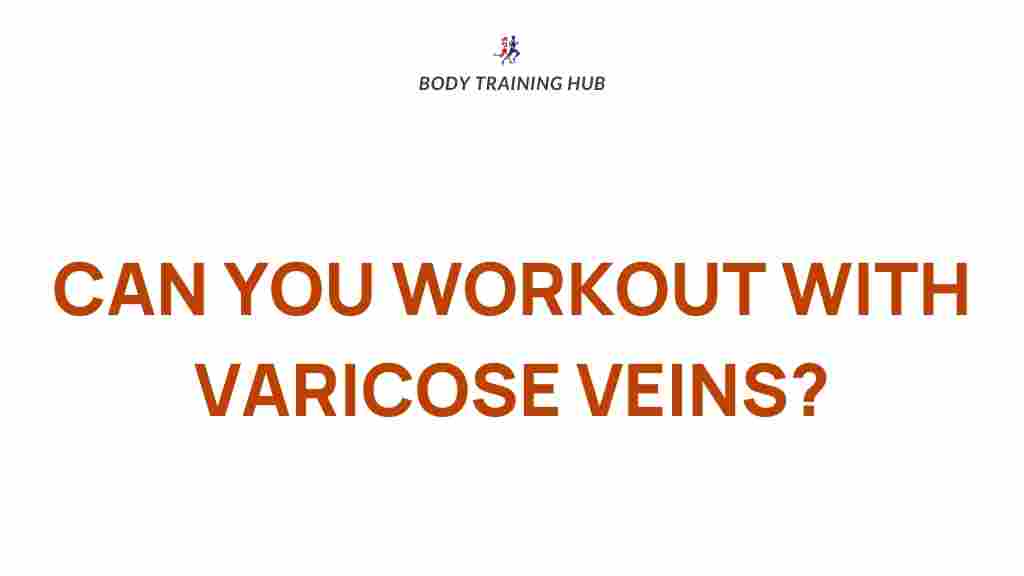Unveiling the Truth: Exercising with Varicose Veins
Varicose veins are a common condition that affects millions of people worldwide. They occur when veins become enlarged and twisted, often leading to discomfort and cosmetic concerns. Many individuals with varicose veins wonder if they can engage in exercise without exacerbating their condition. This article aims to dispel myths, provide facts, and offer guidance on how to exercise safely with varicose veins while maintaining cardiovascular health and achieving body goals.
Understanding Varicose Veins
Before diving into the specifics of exercise, it’s essential to understand what varicose veins are. Varicose veins are veins that have become enlarged and overfilled with blood. They often appear swollen and raised, with a blue or dark purple color. Common symptoms include:
- Aching or heavy feeling in the legs
- Pain after sitting or standing for long periods
- Swelling in the lower legs
- Itching around the veins
While varicose veins can be unsightly, they can also lead to more serious complications if left untreated. Therefore, understanding how to exercise safely is crucial for those affected.
Myths About Exercising with Varicose Veins
When it comes to varicose veins and exercise, several myths persist that can discourage individuals from being active. Let’s clear up some of the most common misconceptions.
- Myth 1: You should avoid all forms of exercise.
- Myth 2: Exercise will make varicose veins worse.
- Myth 3: Only low-impact activities are safe.
These myths can prevent individuals from engaging in beneficial physical activity. In reality, exercise can enhance circulation and contribute positively to overall vascular health.
Facts About Exercising with Varicose Veins
Let’s look at some facts regarding exercise and varicose veins:
- Fact 1: Regular exercise can help improve circulation.
- Fact 2: Specific types of exercise can strengthen the muscles in the legs, which may help support the veins.
- Fact 3: Staying active can help prevent the worsening of varicose veins.
Understanding these facts is crucial for individuals with varicose veins who want to maintain their cardiovascular health and overall well-being.
Benefits of Exercise for Varicose Vein Management
Engaging in regular exercise can provide numerous benefits for those with varicose veins:
- Improved blood circulation, reducing the risk of blood pooling in the legs
- Strengthened leg muscles, which can help support veins
- Weight management, reducing pressure on the veins
- Enhanced overall cardiovascular health
Types of Exercise Safe for Varicose Veins
Now that we’ve debunked some myths and established the benefits, let’s discuss the types of exercise that are safe for individuals with varicose veins.
Cardiovascular Exercises
Cardiovascular (aerobic) exercises are excellent for improving circulation. Here are some safe options:
- Walking: A low-impact activity that promotes circulation without straining the legs.
- Cycling: Whether on a stationary bike or outdoors, cycling can strengthen leg muscles without excessive pressure on the veins.
- Swimming: A fantastic full-body workout that is easy on the joints and promotes blood flow.
Strength Training
Strength training is also beneficial. Here’s how to incorporate it safely:
- Bodyweight exercises: Squats, lunges, and calf raises can enhance muscle strength and support vein health.
- Resistance bands: Using bands to perform leg exercises can help build strength without heavy weights.
- Light weights: If you choose to use weights, opt for lighter ones to avoid excessive strain.
Flexibility and Stretching
Incorporating flexibility exercises can also be beneficial:
- Yoga: Gentle yoga can promote flexibility and relaxation, which may help alleviate discomfort.
- Pilates: Focuses on core strength and stability, aiding in better body mechanics.
Step-by-Step Guide to Exercising with Varicose Veins
Here’s a step-by-step process to incorporate exercise into your routine safely:
- Consult Your Doctor: Always consult with a healthcare professional before starting any exercise program, especially if you have existing health concerns.
- Start Slowly: Begin with low-impact activities like walking. Gradually increase the intensity and duration as your body adjusts.
- Wear Compression Stockings: Consider wearing compression stockings during exercise to support circulation.
- Stay Hydrated: Drink plenty of water before, during, and after exercise.
- Incorporate Rest Days: Allow time for recovery to prevent overexertion and fatigue.
Troubleshooting Tips for Exercising with Varicose Veins
While exercising, you may encounter some challenges. Here are troubleshooting tips to help you manage:
- Discomfort: If you experience pain while exercising, stop and rest. Listen to your body.
- Swelling: Elevate your legs after exercise to reduce swelling. Compression stockings can also help.
- Fatigue: If you feel excessively tired, scale back your workouts and gradually build up your endurance.
Conclusion
Exercising with varicose veins is not only possible but also beneficial for your cardiovascular health and overall well-being. By understanding the myths and facts surrounding varicose veins and exercise, you can make informed decisions about your fitness journey. Remember to consult with a healthcare professional, choose suitable exercises, and listen to your body. With the right approach, you can achieve your body goals while managing varicose veins effectively.
For more information on managing varicose veins, visit this resource. If you’re looking for additional exercise tips, check out our article here.
This article is in the category Myths & Facts and created by BodyTraining Team
